Customer Experience Analysis: Amazon and Traditional Retail Sectors
VerifiedAdded on 2023/06/14
|8
|1821
|437
Report
AI Summary
This report analyzes Amazon's customer experience strategies, highlighting its mission, vision, corporate culture, and brand strategy that positions it as a customer-centric pioneer. It examines Amazon's approach to understanding and serving customer needs, leveraging technology, data, and infrastructure to personalize interactions and ensure timely service. The report contrasts Amazon's strategies with traditional retail practices, suggesting improvements for retailers like Sainsbury, focusing on understanding customer preferences, investing in technology for personalized shopping experiences, and streamlining delivery and customer service. It also delves into the concept of Customer DNA and how data collection and analysis can enhance customer profiling and decision-making. The report concludes by recommending that traditional retailers adopt AI, improve in-store experiences, and focus on timely product information delivery to better meet customer needs and build loyalty, drawing inspiration from Amazon's Kaizen philosophy for continuous improvement.

0Running head: CUSTOMER EXPERIENCE
Customer experience
Name of the Student
Name of the University
Author note
Customer experience
Name of the Student
Name of the University
Author note
Paraphrase This Document
Need a fresh take? Get an instant paraphrase of this document with our AI Paraphraser
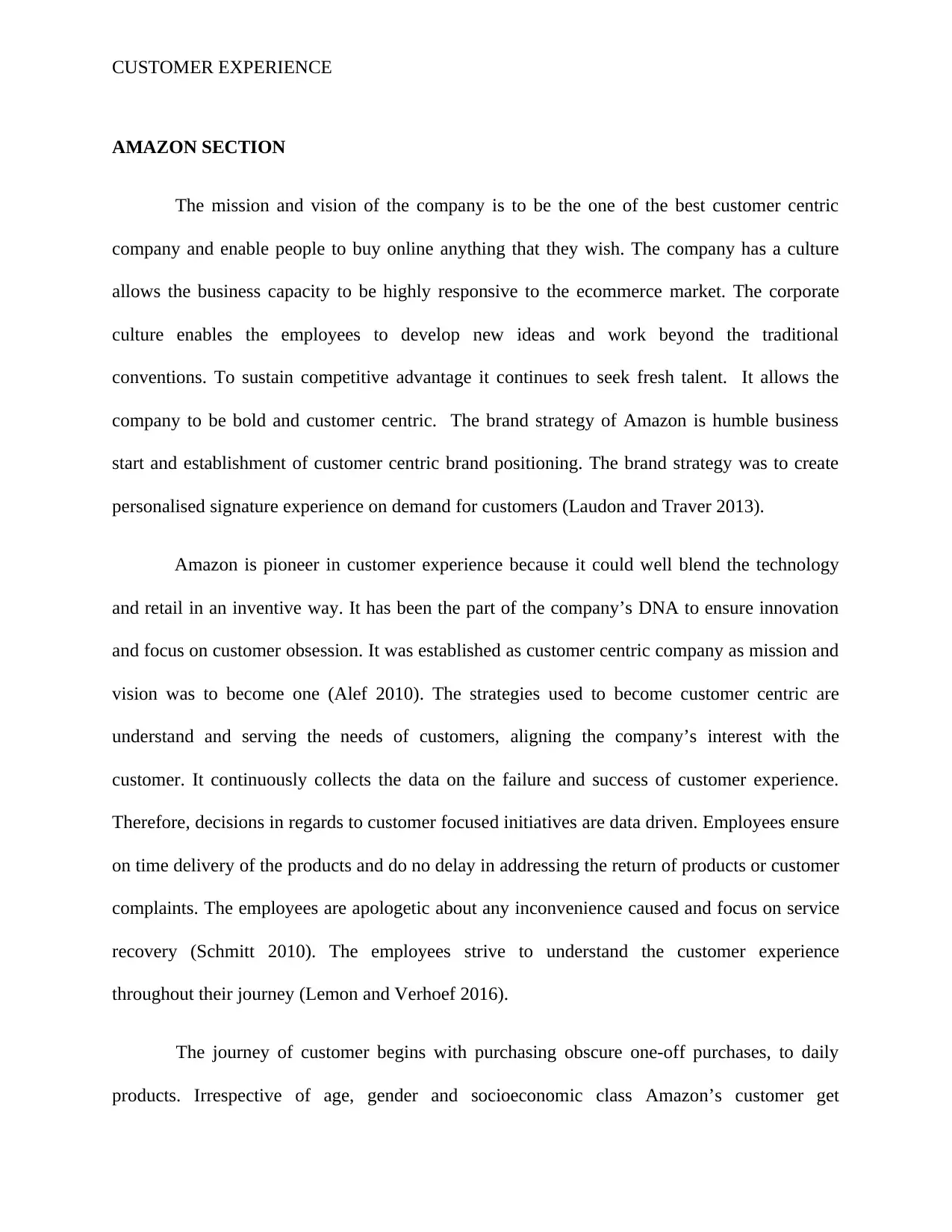
CUSTOMER EXPERIENCE
AMAZON SECTION
The mission and vision of the company is to be the one of the best customer centric
company and enable people to buy online anything that they wish. The company has a culture
allows the business capacity to be highly responsive to the ecommerce market. The corporate
culture enables the employees to develop new ideas and work beyond the traditional
conventions. To sustain competitive advantage it continues to seek fresh talent. It allows the
company to be bold and customer centric. The brand strategy of Amazon is humble business
start and establishment of customer centric brand positioning. The brand strategy was to create
personalised signature experience on demand for customers (Laudon and Traver 2013).
Amazon is pioneer in customer experience because it could well blend the technology
and retail in an inventive way. It has been the part of the company’s DNA to ensure innovation
and focus on customer obsession. It was established as customer centric company as mission and
vision was to become one (Alef 2010). The strategies used to become customer centric are
understand and serving the needs of customers, aligning the company’s interest with the
customer. It continuously collects the data on the failure and success of customer experience.
Therefore, decisions in regards to customer focused initiatives are data driven. Employees ensure
on time delivery of the products and do no delay in addressing the return of products or customer
complaints. The employees are apologetic about any inconvenience caused and focus on service
recovery (Schmitt 2010). The employees strive to understand the customer experience
throughout their journey (Lemon and Verhoef 2016).
The journey of customer begins with purchasing obscure one-off purchases, to daily
products. Irrespective of age, gender and socioeconomic class Amazon’s customer get
AMAZON SECTION
The mission and vision of the company is to be the one of the best customer centric
company and enable people to buy online anything that they wish. The company has a culture
allows the business capacity to be highly responsive to the ecommerce market. The corporate
culture enables the employees to develop new ideas and work beyond the traditional
conventions. To sustain competitive advantage it continues to seek fresh talent. It allows the
company to be bold and customer centric. The brand strategy of Amazon is humble business
start and establishment of customer centric brand positioning. The brand strategy was to create
personalised signature experience on demand for customers (Laudon and Traver 2013).
Amazon is pioneer in customer experience because it could well blend the technology
and retail in an inventive way. It has been the part of the company’s DNA to ensure innovation
and focus on customer obsession. It was established as customer centric company as mission and
vision was to become one (Alef 2010). The strategies used to become customer centric are
understand and serving the needs of customers, aligning the company’s interest with the
customer. It continuously collects the data on the failure and success of customer experience.
Therefore, decisions in regards to customer focused initiatives are data driven. Employees ensure
on time delivery of the products and do no delay in addressing the return of products or customer
complaints. The employees are apologetic about any inconvenience caused and focus on service
recovery (Schmitt 2010). The employees strive to understand the customer experience
throughout their journey (Lemon and Verhoef 2016).
The journey of customer begins with purchasing obscure one-off purchases, to daily
products. Irrespective of age, gender and socioeconomic class Amazon’s customer get
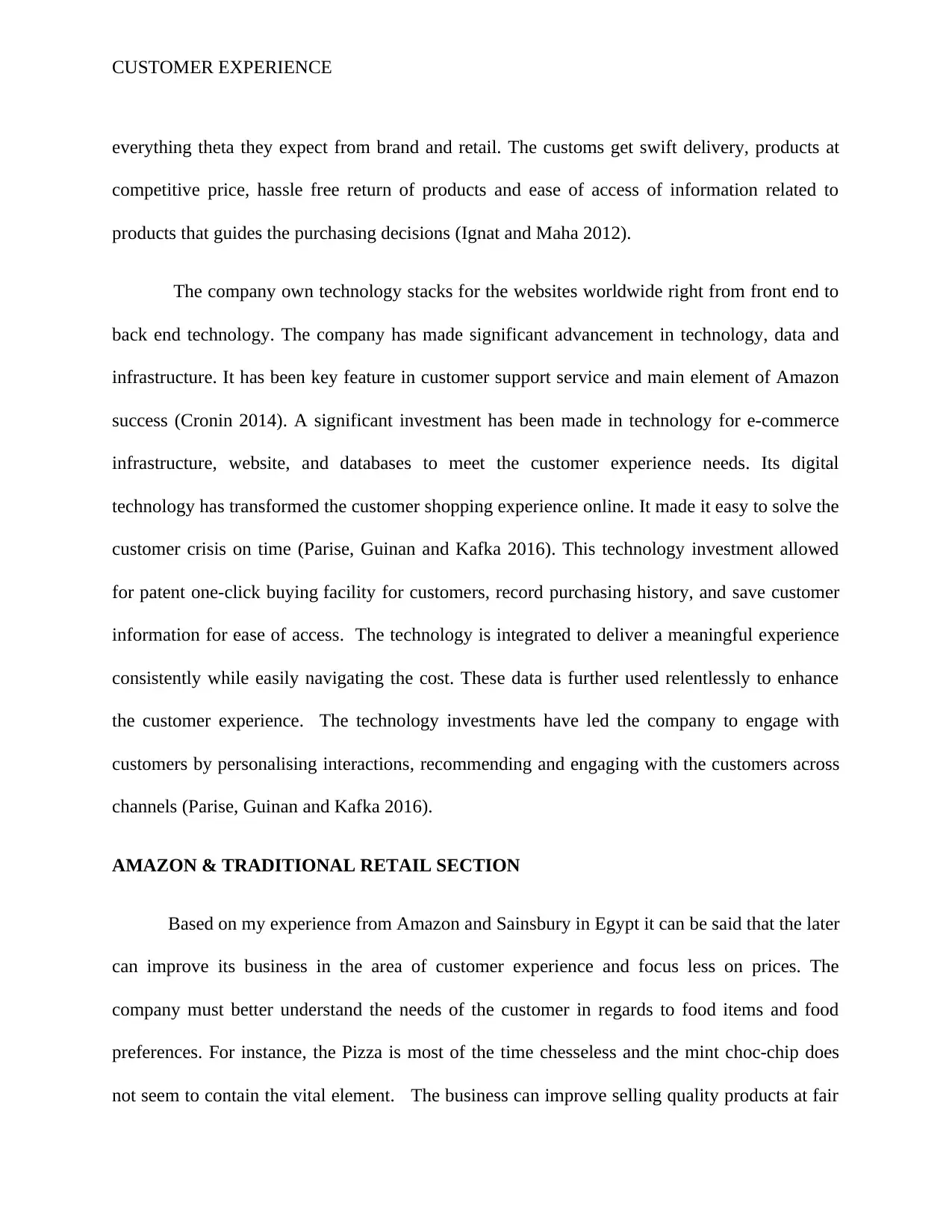
CUSTOMER EXPERIENCE
everything theta they expect from brand and retail. The customs get swift delivery, products at
competitive price, hassle free return of products and ease of access of information related to
products that guides the purchasing decisions (Ignat and Maha 2012).
The company own technology stacks for the websites worldwide right from front end to
back end technology. The company has made significant advancement in technology, data and
infrastructure. It has been key feature in customer support service and main element of Amazon
success (Cronin 2014). A significant investment has been made in technology for e-commerce
infrastructure, website, and databases to meet the customer experience needs. Its digital
technology has transformed the customer shopping experience online. It made it easy to solve the
customer crisis on time (Parise, Guinan and Kafka 2016). This technology investment allowed
for patent one-click buying facility for customers, record purchasing history, and save customer
information for ease of access. The technology is integrated to deliver a meaningful experience
consistently while easily navigating the cost. These data is further used relentlessly to enhance
the customer experience. The technology investments have led the company to engage with
customers by personalising interactions, recommending and engaging with the customers across
channels (Parise, Guinan and Kafka 2016).
AMAZON & TRADITIONAL RETAIL SECTION
Based on my experience from Amazon and Sainsbury in Egypt it can be said that the later
can improve its business in the area of customer experience and focus less on prices. The
company must better understand the needs of the customer in regards to food items and food
preferences. For instance, the Pizza is most of the time chesseless and the mint choc-chip does
not seem to contain the vital element. The business can improve selling quality products at fair
everything theta they expect from brand and retail. The customs get swift delivery, products at
competitive price, hassle free return of products and ease of access of information related to
products that guides the purchasing decisions (Ignat and Maha 2012).
The company own technology stacks for the websites worldwide right from front end to
back end technology. The company has made significant advancement in technology, data and
infrastructure. It has been key feature in customer support service and main element of Amazon
success (Cronin 2014). A significant investment has been made in technology for e-commerce
infrastructure, website, and databases to meet the customer experience needs. Its digital
technology has transformed the customer shopping experience online. It made it easy to solve the
customer crisis on time (Parise, Guinan and Kafka 2016). This technology investment allowed
for patent one-click buying facility for customers, record purchasing history, and save customer
information for ease of access. The technology is integrated to deliver a meaningful experience
consistently while easily navigating the cost. These data is further used relentlessly to enhance
the customer experience. The technology investments have led the company to engage with
customers by personalising interactions, recommending and engaging with the customers across
channels (Parise, Guinan and Kafka 2016).
AMAZON & TRADITIONAL RETAIL SECTION
Based on my experience from Amazon and Sainsbury in Egypt it can be said that the later
can improve its business in the area of customer experience and focus less on prices. The
company must better understand the needs of the customer in regards to food items and food
preferences. For instance, the Pizza is most of the time chesseless and the mint choc-chip does
not seem to contain the vital element. The business can improve selling quality products at fair
⊘ This is a preview!⊘
Do you want full access?
Subscribe today to unlock all pages.

Trusted by 1+ million students worldwide
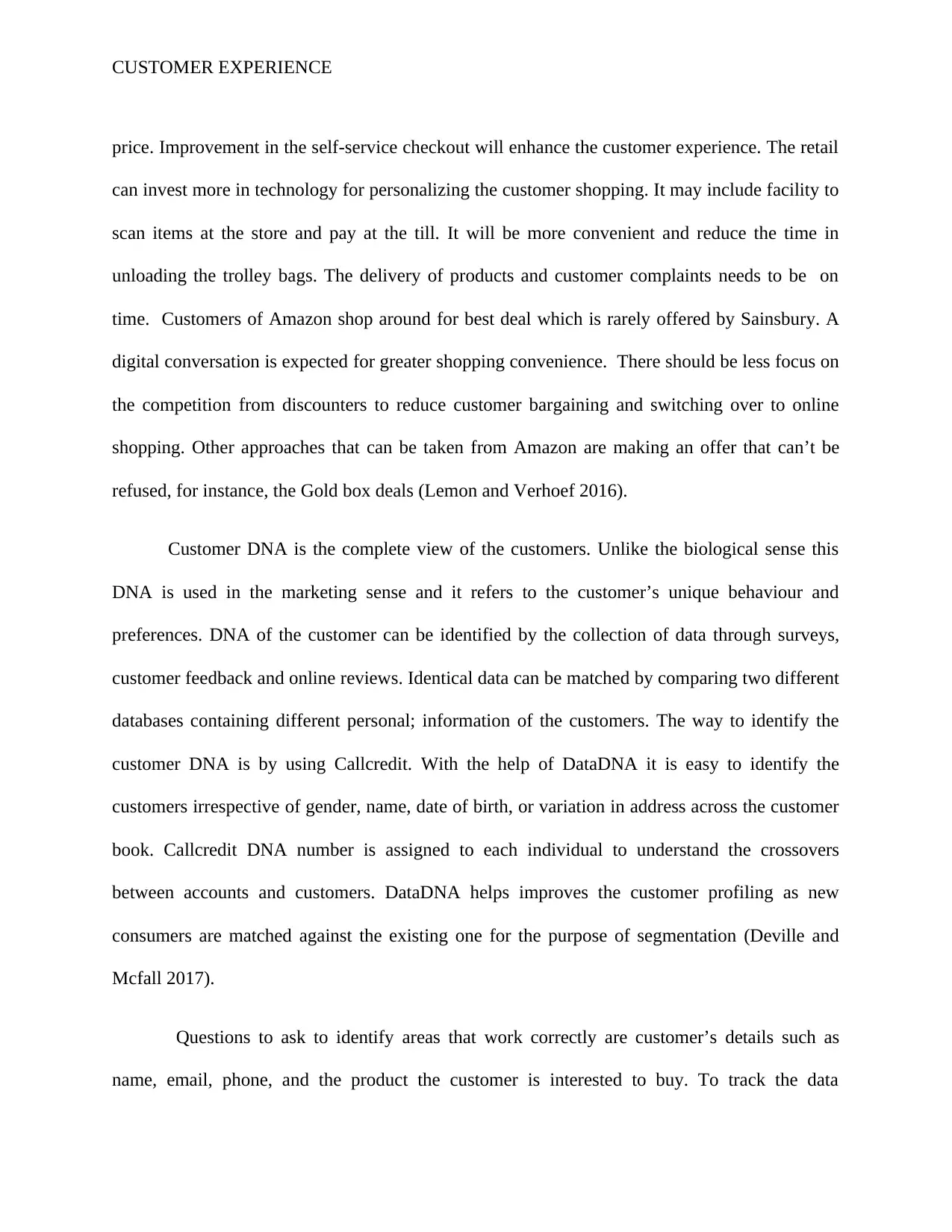
CUSTOMER EXPERIENCE
price. Improvement in the self-service checkout will enhance the customer experience. The retail
can invest more in technology for personalizing the customer shopping. It may include facility to
scan items at the store and pay at the till. It will be more convenient and reduce the time in
unloading the trolley bags. The delivery of products and customer complaints needs to be on
time. Customers of Amazon shop around for best deal which is rarely offered by Sainsbury. A
digital conversation is expected for greater shopping convenience. There should be less focus on
the competition from discounters to reduce customer bargaining and switching over to online
shopping. Other approaches that can be taken from Amazon are making an offer that can’t be
refused, for instance, the Gold box deals (Lemon and Verhoef 2016).
Customer DNA is the complete view of the customers. Unlike the biological sense this
DNA is used in the marketing sense and it refers to the customer’s unique behaviour and
preferences. DNA of the customer can be identified by the collection of data through surveys,
customer feedback and online reviews. Identical data can be matched by comparing two different
databases containing different personal; information of the customers. The way to identify the
customer DNA is by using Callcredit. With the help of DataDNA it is easy to identify the
customers irrespective of gender, name, date of birth, or variation in address across the customer
book. Callcredit DNA number is assigned to each individual to understand the crossovers
between accounts and customers. DataDNA helps improves the customer profiling as new
consumers are matched against the existing one for the purpose of segmentation (Deville and
Mcfall 2017).
Questions to ask to identify areas that work correctly are customer’s details such as
name, email, phone, and the product the customer is interested to buy. To track the data
price. Improvement in the self-service checkout will enhance the customer experience. The retail
can invest more in technology for personalizing the customer shopping. It may include facility to
scan items at the store and pay at the till. It will be more convenient and reduce the time in
unloading the trolley bags. The delivery of products and customer complaints needs to be on
time. Customers of Amazon shop around for best deal which is rarely offered by Sainsbury. A
digital conversation is expected for greater shopping convenience. There should be less focus on
the competition from discounters to reduce customer bargaining and switching over to online
shopping. Other approaches that can be taken from Amazon are making an offer that can’t be
refused, for instance, the Gold box deals (Lemon and Verhoef 2016).
Customer DNA is the complete view of the customers. Unlike the biological sense this
DNA is used in the marketing sense and it refers to the customer’s unique behaviour and
preferences. DNA of the customer can be identified by the collection of data through surveys,
customer feedback and online reviews. Identical data can be matched by comparing two different
databases containing different personal; information of the customers. The way to identify the
customer DNA is by using Callcredit. With the help of DataDNA it is easy to identify the
customers irrespective of gender, name, date of birth, or variation in address across the customer
book. Callcredit DNA number is assigned to each individual to understand the crossovers
between accounts and customers. DataDNA helps improves the customer profiling as new
consumers are matched against the existing one for the purpose of segmentation (Deville and
Mcfall 2017).
Questions to ask to identify areas that work correctly are customer’s details such as
name, email, phone, and the product the customer is interested to buy. To track the data
Paraphrase This Document
Need a fresh take? Get an instant paraphrase of this document with our AI Paraphraser
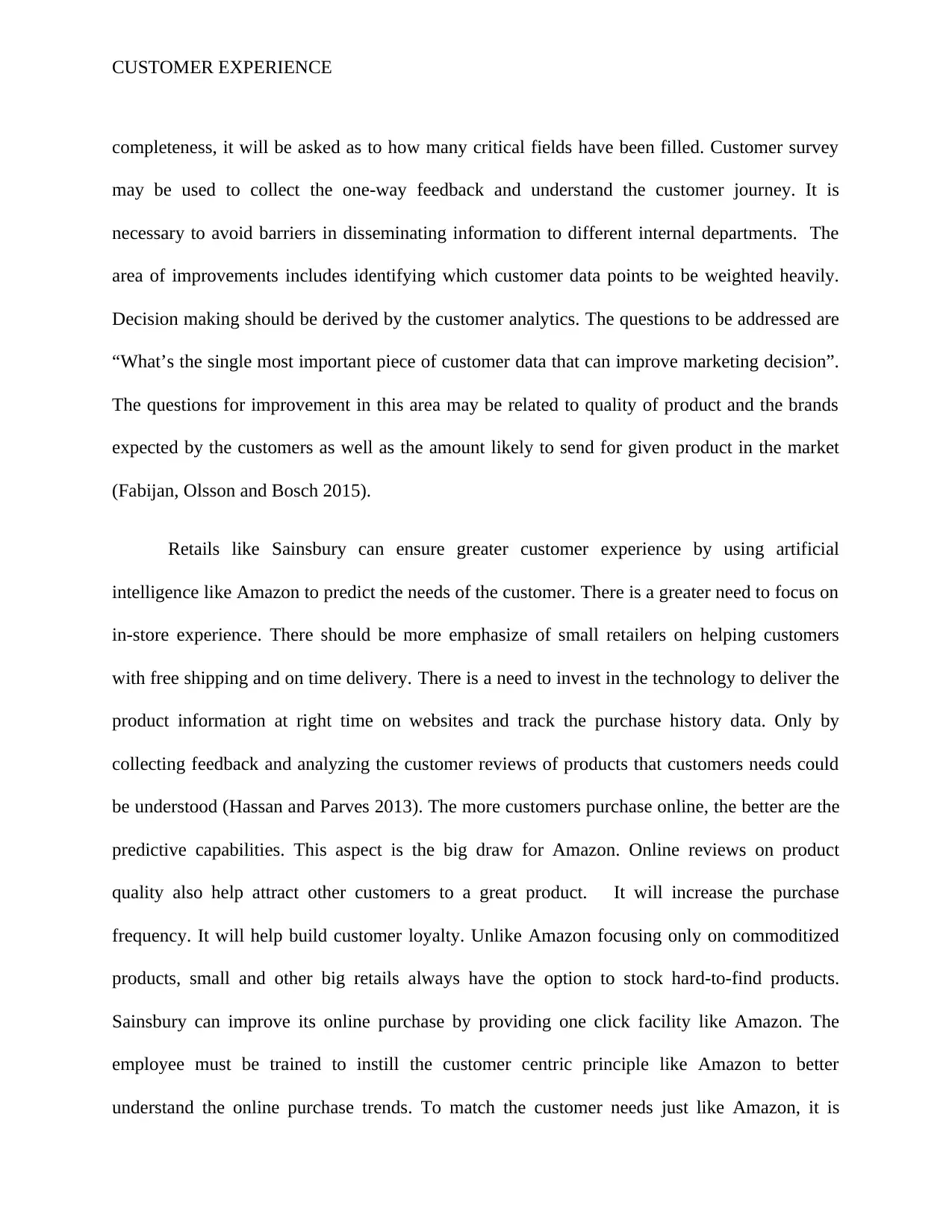
CUSTOMER EXPERIENCE
completeness, it will be asked as to how many critical fields have been filled. Customer survey
may be used to collect the one-way feedback and understand the customer journey. It is
necessary to avoid barriers in disseminating information to different internal departments. The
area of improvements includes identifying which customer data points to be weighted heavily.
Decision making should be derived by the customer analytics. The questions to be addressed are
“What’s the single most important piece of customer data that can improve marketing decision”.
The questions for improvement in this area may be related to quality of product and the brands
expected by the customers as well as the amount likely to send for given product in the market
(Fabijan, Olsson and Bosch 2015).
Retails like Sainsbury can ensure greater customer experience by using artificial
intelligence like Amazon to predict the needs of the customer. There is a greater need to focus on
in-store experience. There should be more emphasize of small retailers on helping customers
with free shipping and on time delivery. There is a need to invest in the technology to deliver the
product information at right time on websites and track the purchase history data. Only by
collecting feedback and analyzing the customer reviews of products that customers needs could
be understood (Hassan and Parves 2013). The more customers purchase online, the better are the
predictive capabilities. This aspect is the big draw for Amazon. Online reviews on product
quality also help attract other customers to a great product. It will increase the purchase
frequency. It will help build customer loyalty. Unlike Amazon focusing only on commoditized
products, small and other big retails always have the option to stock hard-to-find products.
Sainsbury can improve its online purchase by providing one click facility like Amazon. The
employee must be trained to instill the customer centric principle like Amazon to better
understand the online purchase trends. To match the customer needs just like Amazon, it is
completeness, it will be asked as to how many critical fields have been filled. Customer survey
may be used to collect the one-way feedback and understand the customer journey. It is
necessary to avoid barriers in disseminating information to different internal departments. The
area of improvements includes identifying which customer data points to be weighted heavily.
Decision making should be derived by the customer analytics. The questions to be addressed are
“What’s the single most important piece of customer data that can improve marketing decision”.
The questions for improvement in this area may be related to quality of product and the brands
expected by the customers as well as the amount likely to send for given product in the market
(Fabijan, Olsson and Bosch 2015).
Retails like Sainsbury can ensure greater customer experience by using artificial
intelligence like Amazon to predict the needs of the customer. There is a greater need to focus on
in-store experience. There should be more emphasize of small retailers on helping customers
with free shipping and on time delivery. There is a need to invest in the technology to deliver the
product information at right time on websites and track the purchase history data. Only by
collecting feedback and analyzing the customer reviews of products that customers needs could
be understood (Hassan and Parves 2013). The more customers purchase online, the better are the
predictive capabilities. This aspect is the big draw for Amazon. Online reviews on product
quality also help attract other customers to a great product. It will increase the purchase
frequency. It will help build customer loyalty. Unlike Amazon focusing only on commoditized
products, small and other big retails always have the option to stock hard-to-find products.
Sainsbury can improve its online purchase by providing one click facility like Amazon. The
employee must be trained to instill the customer centric principle like Amazon to better
understand the online purchase trends. To match the customer needs just like Amazon, it is

CUSTOMER EXPERIENCE
recommended to use the philosophy of Kaizen. It is to maximise the efficiency using the
elements like order processing that directly impacts the bottom line (Ritala, Golnam and
Wegmann 2014).
recommended to use the philosophy of Kaizen. It is to maximise the efficiency using the
elements like order processing that directly impacts the bottom line (Ritala, Golnam and
Wegmann 2014).
⊘ This is a preview!⊘
Do you want full access?
Subscribe today to unlock all pages.

Trusted by 1+ million students worldwide
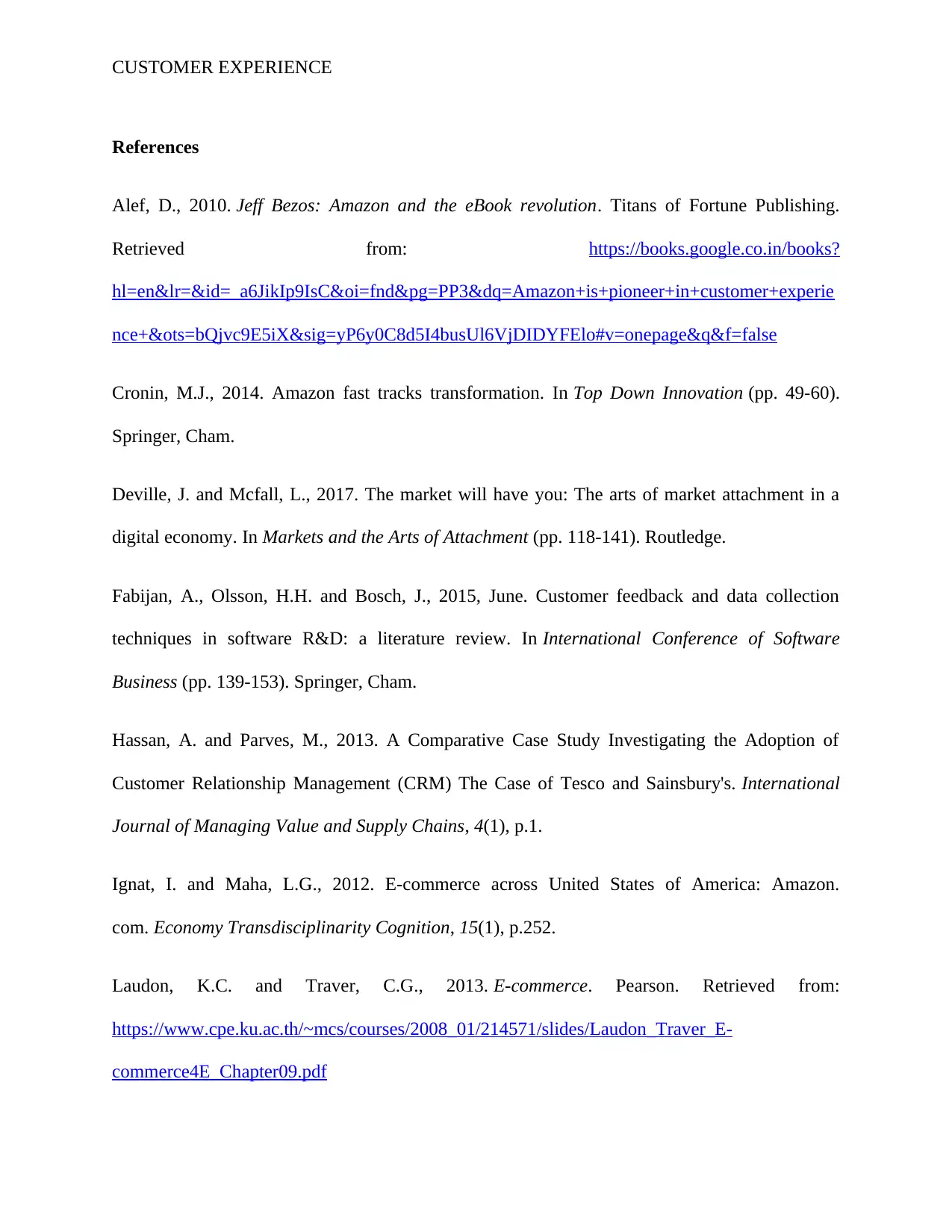
CUSTOMER EXPERIENCE
References
Alef, D., 2010. Jeff Bezos: Amazon and the eBook revolution. Titans of Fortune Publishing.
Retrieved from: https://books.google.co.in/books?
hl=en&lr=&id=_a6JikIp9IsC&oi=fnd&pg=PP3&dq=Amazon+is+pioneer+in+customer+experie
nce+&ots=bQjvc9E5iX&sig=yP6y0C8d5I4busUl6VjDIDYFElo#v=onepage&q&f=false
Cronin, M.J., 2014. Amazon fast tracks transformation. In Top Down Innovation (pp. 49-60).
Springer, Cham.
Deville, J. and Mcfall, L., 2017. The market will have you: The arts of market attachment in a
digital economy. In Markets and the Arts of Attachment (pp. 118-141). Routledge.
Fabijan, A., Olsson, H.H. and Bosch, J., 2015, June. Customer feedback and data collection
techniques in software R&D: a literature review. In International Conference of Software
Business (pp. 139-153). Springer, Cham.
Hassan, A. and Parves, M., 2013. A Comparative Case Study Investigating the Adoption of
Customer Relationship Management (CRM) The Case of Tesco and Sainsbury's. International
Journal of Managing Value and Supply Chains, 4(1), p.1.
Ignat, I. and Maha, L.G., 2012. E-commerce across United States of America: Amazon.
com. Economy Transdisciplinarity Cognition, 15(1), p.252.
Laudon, K.C. and Traver, C.G., 2013. E-commerce. Pearson. Retrieved from:
https://www.cpe.ku.ac.th/~mcs/courses/2008_01/214571/slides/Laudon_Traver_E-
commerce4E_Chapter09.pdf
References
Alef, D., 2010. Jeff Bezos: Amazon and the eBook revolution. Titans of Fortune Publishing.
Retrieved from: https://books.google.co.in/books?
hl=en&lr=&id=_a6JikIp9IsC&oi=fnd&pg=PP3&dq=Amazon+is+pioneer+in+customer+experie
nce+&ots=bQjvc9E5iX&sig=yP6y0C8d5I4busUl6VjDIDYFElo#v=onepage&q&f=false
Cronin, M.J., 2014. Amazon fast tracks transformation. In Top Down Innovation (pp. 49-60).
Springer, Cham.
Deville, J. and Mcfall, L., 2017. The market will have you: The arts of market attachment in a
digital economy. In Markets and the Arts of Attachment (pp. 118-141). Routledge.
Fabijan, A., Olsson, H.H. and Bosch, J., 2015, June. Customer feedback and data collection
techniques in software R&D: a literature review. In International Conference of Software
Business (pp. 139-153). Springer, Cham.
Hassan, A. and Parves, M., 2013. A Comparative Case Study Investigating the Adoption of
Customer Relationship Management (CRM) The Case of Tesco and Sainsbury's. International
Journal of Managing Value and Supply Chains, 4(1), p.1.
Ignat, I. and Maha, L.G., 2012. E-commerce across United States of America: Amazon.
com. Economy Transdisciplinarity Cognition, 15(1), p.252.
Laudon, K.C. and Traver, C.G., 2013. E-commerce. Pearson. Retrieved from:
https://www.cpe.ku.ac.th/~mcs/courses/2008_01/214571/slides/Laudon_Traver_E-
commerce4E_Chapter09.pdf
Paraphrase This Document
Need a fresh take? Get an instant paraphrase of this document with our AI Paraphraser
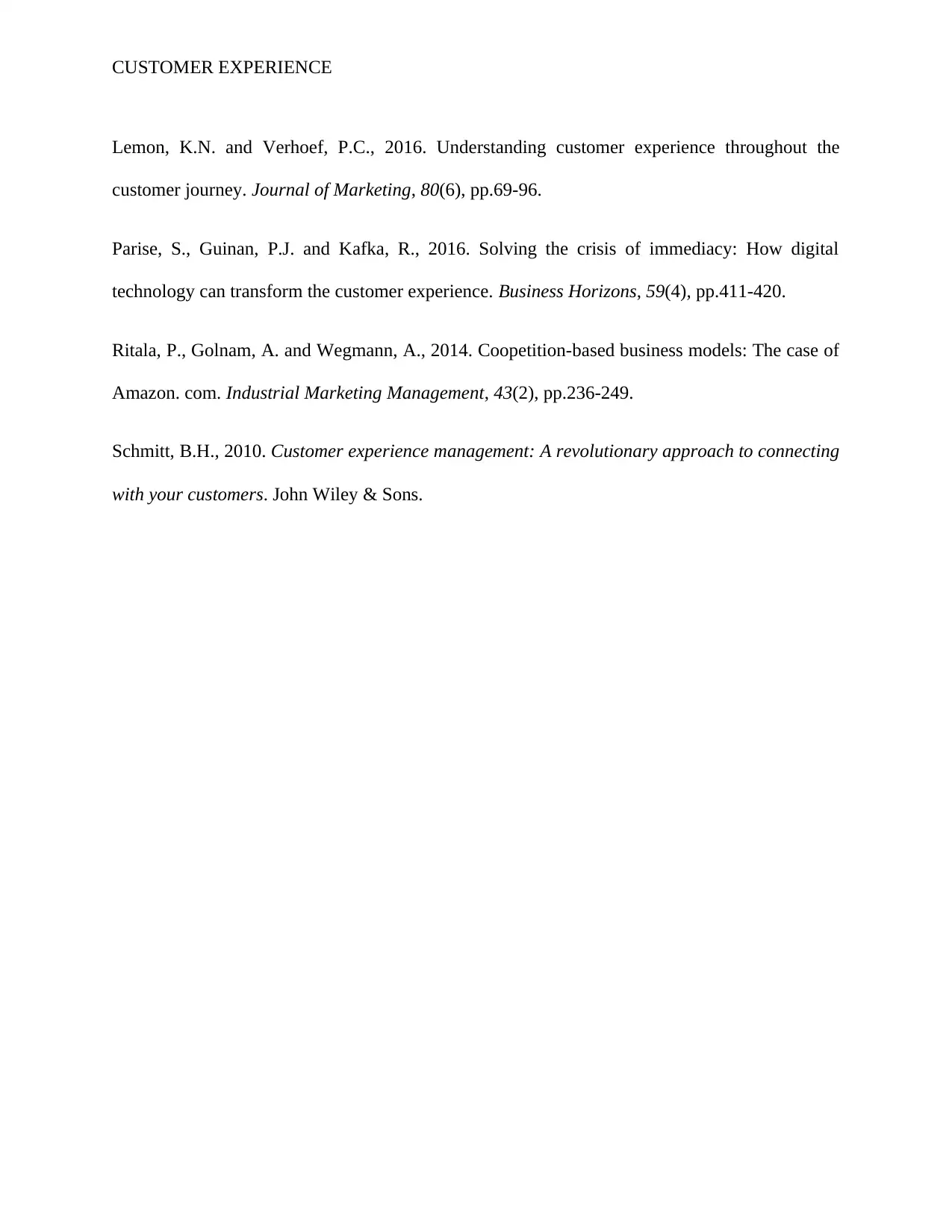
CUSTOMER EXPERIENCE
Lemon, K.N. and Verhoef, P.C., 2016. Understanding customer experience throughout the
customer journey. Journal of Marketing, 80(6), pp.69-96.
Parise, S., Guinan, P.J. and Kafka, R., 2016. Solving the crisis of immediacy: How digital
technology can transform the customer experience. Business Horizons, 59(4), pp.411-420.
Ritala, P., Golnam, A. and Wegmann, A., 2014. Coopetition-based business models: The case of
Amazon. com. Industrial Marketing Management, 43(2), pp.236-249.
Schmitt, B.H., 2010. Customer experience management: A revolutionary approach to connecting
with your customers. John Wiley & Sons.
Lemon, K.N. and Verhoef, P.C., 2016. Understanding customer experience throughout the
customer journey. Journal of Marketing, 80(6), pp.69-96.
Parise, S., Guinan, P.J. and Kafka, R., 2016. Solving the crisis of immediacy: How digital
technology can transform the customer experience. Business Horizons, 59(4), pp.411-420.
Ritala, P., Golnam, A. and Wegmann, A., 2014. Coopetition-based business models: The case of
Amazon. com. Industrial Marketing Management, 43(2), pp.236-249.
Schmitt, B.H., 2010. Customer experience management: A revolutionary approach to connecting
with your customers. John Wiley & Sons.
1 out of 8
Related Documents
Your All-in-One AI-Powered Toolkit for Academic Success.
+13062052269
info@desklib.com
Available 24*7 on WhatsApp / Email
![[object Object]](/_next/static/media/star-bottom.7253800d.svg)
Unlock your academic potential
Copyright © 2020–2025 A2Z Services. All Rights Reserved. Developed and managed by ZUCOL.





